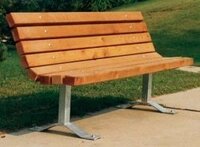 Two characters enter a park, and are seated at benches close to each other. They strike up some interesting conversation, and eventually exit. Without getting into the content of the dialogue, and the plot surpirses -- essentially that is the premise (from a technical standpoint). Here are my thoughts about how to approach it for sound (and camera).
Two characters enter a park, and are seated at benches close to each other. They strike up some interesting conversation, and eventually exit. Without getting into the content of the dialogue, and the plot surpirses -- essentially that is the premise (from a technical standpoint). Here are my thoughts about how to approach it for sound (and camera).
Being in film school means that you get to make films, make mistakes, and then eventually make better films! But it also means that you have access to some wise and seasoned faculty advisors, whom students should consult as often as they can. We have been there, and done that! It is not our first day out to the rodeo, as the expression goes. So fly your ideas by us, and listen to our suggestions.
A group of students are planning to shoot the above described film in a very scenic public park, located deep in the center of a metropolitan city. They are impressed with the visual characteristics of said park. However, there are a few issues that I have with the plan.
To begin with, it is a PUBLIC park, and even with filmming permits -- there is no way to exert complete control over all natural activity. The city is not going to close the entire park for their benefit. That means that the locals may or may not visit the park at any given day or time. There may or may not be activities in the background. Maintaining continutiy is going to be a real bear!
Sound is a major problem. The park may look good, but it is very noisy. Major traffic close by. Plus, the sounds of whoever is out in the park. Mind you, this whole script relies upon the spoken word -- there is very little physical action.
At the center of the location site are two permanent park benches. Unfortunately, the two benches face AWAY from each other. Yet the students chose to use them! It makes for awkward body positions for the actors, and difficult visual composition.
So what would be my advice?
To begin with, rent a couple of park benches and a few "park" props, such as a trash can, and a (chess) table/pedestal. Establish them at the location, and angle the benches for optimum staging, composition, control of background visuals, and angle of the sun. Shoot your wide entrance shots, establishing shots, and final exits.
Then, pack it all up and move to a more secure and quiet location. Recreate your set, and shoot the balance of the movie under more controlled conditions! During the shoot, cheat the position and angles of the benches to accommodate the changing angle of the sun, as needed. Or adjust their placement to enhance the drama. Bottom line -- the filmmakers are in control!
After the principal photography is complete, and the editing phase has begun -- the need may arise for some pickup shots. Perhaps there are some gaps in the original script, or there needs to be some tightening up. Being able to recreate the set, using your benches & props, makes it easy to add new footage.
That's the way Hollywood would have done it. Don't know if the students will heed my suggestions about renting benches and using a second location or not.
Let's look at how we will deal with the audio.
The sound mixer likes the use of a long shotgun microphone, boomed from overhead. The shotgun mic yields a very natural sound, along with realistic sound effects & texture. I agree. Since there was only one principal microphone, the mixer felt that using a two-track digital recorder would be sufficient.
However, being outside, and in a public park surrounded by uncontrollable background noise -- we need to plan for the worst. There is also the likelihood that the Director may abandon the storyboard from time to time and "improve" upon the original blocking.
Therefore, let's take advantage of multi-track so that we can have our cake and eat it too. Instead of the two-track, let's opt for a four-track digital recorder (with timecode) such as the Sound Devices 744T. Add two radio mics, so that each actor is completely covered no matter what.
The radio mics should be paired with a good quality, proximity type lavalier such as the Countryman B3, that will hold back as much of the background as possible. Remember, when you rent wireless microphones, you have to pay attention to the make & model of the lavalier; not just the make and model of the transmitters and receivers.
Run each of the wireless lavs directly into the recorder, on tracks 1 and 2. Set their levels, and just let them be recorded as ISO tracks. Deploy a small mixing panel, and run that as line level into tracks 3 & 4 of the Sound Devices. The mixing panel will give you full control of the boom mic (track 3), and allow you to output audio to the boom operator and to a Comtek assistive listening system (wireless headphone feed) for the Director, Script Supervisor, and anyone else who needs to monitor the take. Any additional microphones (plant mics, sound effects, backgrounds) could be mixed onto track 4.
Anyway, that is how I would have done it.
